As an Amazon Associate I earn from qualifying purchases.
If you’ve got a pond, chances are you’ve dealt with algae, that green, slimy nuisance turning your water into a murky mess. Pond owners are turning to pond plants for algae control and ditching harsh chemicals.
These plants work by blocking sunlight, absorbing excess nutrients, and restoring balance to the water. In this article, you’ll find the best types of plants to reduce algae naturally, how they work, and where to place them for the best results.
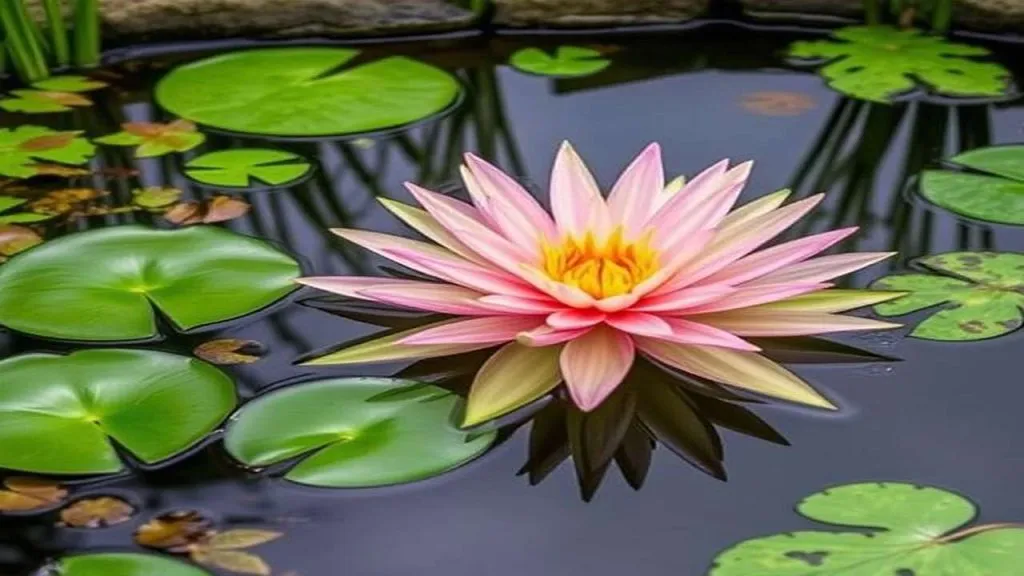
Understanding Algae Control in Ponds
A little algae is normal, but too much can throw everything off balance.
A. Definition and Types of Algae
Algae are simple aquatic organisms that grow quickly in sunlight and nutrient-rich water. In ponds, a few types are especially common:
- Green algae: Makes the water look green or cloudy, sometimes forming a slimy layer.
- String algae: Forms long, hair-like strands that cling to rocks, plants, and surfaces. String algae is easy to spot but harder to control.
- Blue-green algae (cyanobacteria): Technically a type of bacteria, it can produce toxins harmful to fish, pets, and even humans. It often forms slimy surface scums or mats.
These algae thrive in still-warm water with many nutrients, especially nitrogen and phosphorus from fish waste or fertilizer runoff.
B. Impact of Algae on Pond Ecosystems
When algae die and decompose, they use up a lot of oxygen, making it harder for fish and beneficial bacteria to survive.
The thick growth also blocks sunlight, affecting the growth of aquatic plants and adding stress to fish trying to live in unstable conditions. A heavily algae-covered pond water can also start to smell and lose the clean look owners enjoy.
C. Importance of Natural Balance in Pond Management
Chemical treatments offer quick relief, but they’re not a long-term fix, and they can harm the very life you’re trying to protect.
Natural methods, like adding the right pond plants, help by soaking up excess nutrients and shading the water. This limits growth of algae while supporting the pond’s overall health.
One of the most effective ways to support this balance is by using the right aquatic plants, let’s look at how they help control algae naturally.
Benefits of Using Aquatic Plants for Algae Control
Harsh chemicals help get rid of the algae momentarily but also harm the fish and aren’t a great long-term option, using pond plants for algae control is the safest bet.
A. Nutrient Competition With Algae
Aquatic plants absorb excess nutrients like nitrogen and phosphorus from the water, which algae need to grow.
The plants help prevent harmful algae blooms by reducing primary food sources of algae. This nutrient competition stops algae from thriving and maintains a healthier environment for fish and other aquatic life.
B. Natural Water Filtration and Oxygenation
Some submerged aquatic plants work as natural filters by trapping and removing sediments and pollutants. Species like hornwort and anacharis oxygenate the water through photosynthesis, this dissolved oxygen helps the fish stay healthy and beneficial bacteria thrive.
C. Shade Provision to Limit Algae Growth
Algae rely on sunlight for photosynthesis, and floating and emergent plants like water surface lilies and lotus have broad leaves that reduce the sunlight that goes through.
If you place these plants strategically, the low sunlight will stunt algae growth and help maintain the pond ecosystem balance.
D. Enhancement of Pond Aesthetics and Wildlife Attraction
Aquatic plants bring beauty to ponds while fighting algae, their diverse colors, textures, and forms make a simple pond look aesthetic. Beyond the beauty, they also create habitats and food sources for wildlife including fish, frogs, and beneficial insects, creating a balanced ecosystem.
Now that we understand how plants help manage algae, let’s look at the best types for your pond.
Types of Effective Pond Plants for Algae Management
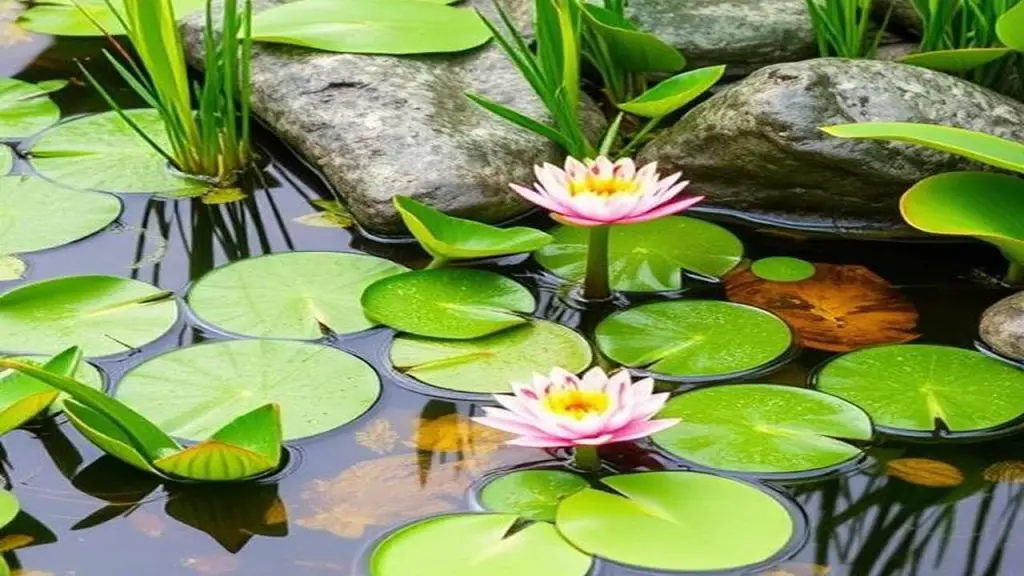
Different types of aquatic pond plants serve different purposes, some soak nutrients, some shade water, and some filter it. Here’s a breakdown of the best pond water plants for algae control with tips to make them work for you:
A. Floating Plants
Floating plants drift on the surface, blocking sunlight while cleaning up excess nutrients. These are some of the fastest to remove algae.
Water Hyacinth (Eichhornia crassipes):
- Benefits: Reduces algae by shading and nutrient competition; attracts pollinators, has beautiful purple flowers.
- Maintenance: Thin regularly to prevent overgrowth; not frost-tolerant.
- Best for: Warm, open ponds with plenty of light.
Water Lettuce (Pistia stratiotes):
- Benefits: Blocks sunlight with its rosette-shaped leaves, absorbs nutrients, and adds texture.
- Maintenance: Scoop out dead or excess leaves to maintain balance.
- Best for: Calm, warm ponds needing surface cover.
B. Submerged Plants
These types of pond plants stay underwater, oxygenate the pond, absorb excess nutrients, and clean the water.
Anacharis (Elodea canadensis):
- Benefits: One of the best oxygenators, supports fish, is beginner friendly, grows quickly, and absorbs nutrients fast.
- Maintenance: Trim to control spread; can be anchored or left to float.
- Best for: Most pond types, especially in full to partial sun.
Cabomba (Cabomba caroliniana)
- Benefits: Attractive feathery leaves and effective at preventing algae.
- Maintenance: Needs moderate light; slightly more sensitive to cold.
- Best for: Warmer ponds with stable temperatures.
Hornwort (Ceratophyllum demersum):
- Benefits: Hardy and adaptable, grows in various light conditions, doesn’t root, can float freely.
- Maintenance: Cut back if too dense.
- Best for: Any pond, especially those with varying light.
C. Emergent Plants
These plants are rooted in the water but grow above the surface, helping to stabilize pond edges and filter runoff.
Pickerelweed (Pontederia cordata):
- Benefits: Filters runoff, competes with algae, and attracts bees and butterflies.
- Maintenance: Divide every few years to manage size.
- Best for: Pond edges with shallow water and sun.
D. Marginal Plants
Marginal plants grow in shallow water along the pond’s edge. They help with filtration, add beauty, and control erosion.
Iris (Iris pseudacorus):
- Benefits: Eye-catching spring blooms, filters water, reduces nutrients, and controls erosion.
- Maintenance: Cut back dead foliage; keep contained.
- Best for: Shallow edges needing color.
Caution: Toxic to pets if ingested.Sweet Flag (Acorus calamus):
- Benefits: Filters water, aromatic and visually appealing, and prevents edge erosion.
- Maintenance: Low upkeep; divide if crowded.
- Best for: Small ponds or decorative edges.
Here’s a quick comparison table to make things easy:
| Plant Type | Key Benefit | Best For | Caution |
| Water Hyacinth | Surface shade, rapid nutrient uptake | Large, sunny ponds | Can overgrow without management |
| Anacharis | Oxygenates, absorbs nutrients | Most ponds | Needs trimming to prevent overgrowth |
| Pickerelweed | Filters runoff, attracts wildlife | Pond edges | Grows tall, may crowd if unchecked |
| Iris (Yellow Flag) | Filters and adds color | Shallow edges, aesthetics | Toxic to pets if ingested |
Now that you know the best algae-eating plants, let’s explore how to choose the right mix and care for them.
Strategies for Optimal Plant Selection and Placement
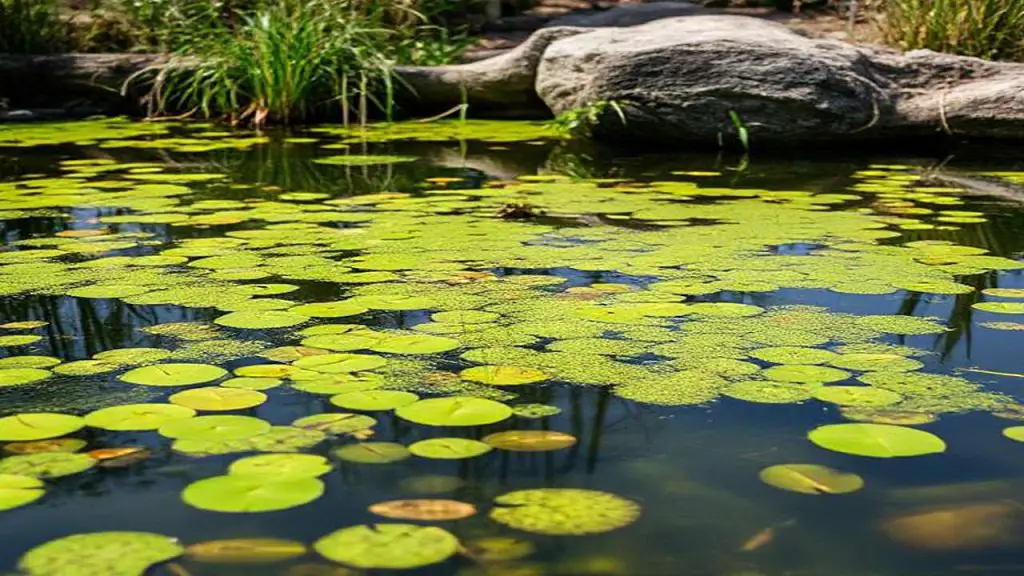
Selecting the right plants for algae control helps, but placing them at the right spot makes all the difference. Let’s break down the smart strategies.
A. Considering Cool and Warm Season Varieties
Algae is a year-long problem, the solution? Get plants that work the whole year as well.
- Cool-season plants like Water Hawthorn and native rushes start early and stretch into fall.
- Warm-season plants like Water Hyacinth and Pickerelweed thrive in summer when algae spikes.
Mix these two in your ponds and you’re good to go.
B. Creating Terraced Shelves for Plant Diversity
Terraced shelves allow you to position your aquatic plants at their ideal water level. It helps:
- Marginal plants root in shallow areas
- Emergent plants sit deeper and submerged below them
- Floating species naturally take their place on the surface
Shelves boost root health and plant coverage, starving algae of light and nutrients.
C. Using Containers for Specific Plants
Some aquatic plants like Water Lettuce and Anacharis grow super fast and can take over the whole pond if left unchecked. Keeping them in a submerged pots or mesh container:
- Prevents unwanted spreads and competition
- Makes it easier to move them
- Makes seasonal cleaning super easy
Quick Tip: Use gravel instead of soil to prevent nutrient leaks that could feed algae.D. Balancing Different Plant Types for Year-Round Control
A mix of plant varieties is crucial for pond ecosystem balance. This mimics a natural pond and makes algae control almost effortless. Floating plants like Water Lettuce shade the surface, submerged ones like Hornwort oxygenate and grab nutrients, and marginals like Iris filter runoff along edges. Aim for this checklist to hit the sweet spot:
✅ 40% floating surface cover
✅ 30–50% submerged volume
✅ 60–70% shoreline covered with marginals
With your plants strategically in place, it’s time to look at how smart pond design and upkeep can take your algae prevention to the next level.
Pond Design and Maintenance for Algae Prevention
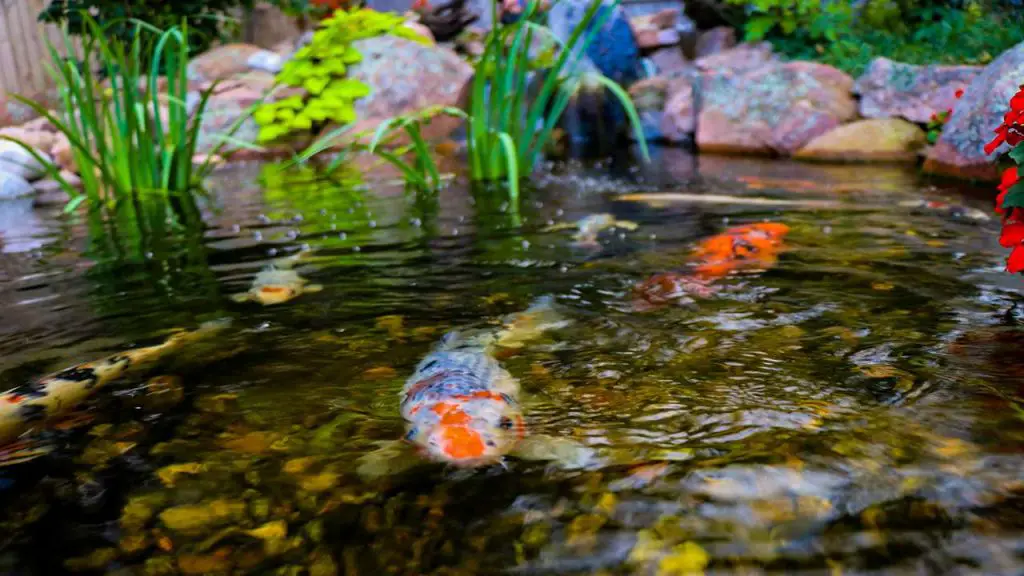
A smart design and maintenance routine helps maintain a pond ecosystem balance. It’s always better to stop algae from starting instead of fighting it.
A. Proper Pond Construction Techniques
The shape, depth, and placement of the pond matter for algae management. Here’s how to design effectively:
- Go deep: Keep it a minimum of 2-3 feet deep to keep the water cooler, shallow ponds heat up fast, inviting algae.
- Add terraces: As we read earlier, terraces help manage plants.
- Avoid all-day direct sunlight: The perfect place would be where the pond can get morning and evening sun.
B. Optimal Placement of Skimmers and Filtration Systems
A filtration system will capture organic debris like leaves etc. before algae can break it down for food. Here are some key placement tips:
- Skimmers should be installed in areas with high surface movement, such as near waterfalls or inlets.
- Biological filters encourage the growth of beneficial bacteria that break down excess nutrients.
- Natural filtration like gravel beds or wetland plants like cattails can boost mechanical systems for a cleaner pond.
C. Gradual Introduction of Fish Stocks
Fish add beauty and life to the pond, adding too many of them at once will spike waste and nutrients, encouraging algae growth. Here’s how to do it right:
- Start small: Wait a few weeks after planting, giving them time to settle.
- Rule of thumb: 1 inch of fish, per 5 gallons of water, while also considering your species needs.
- Bonus perk: Fish munch on larvae and small algae, helping keep things tidy.
Gradual stocking will keep your pond balanced.
D. Regular Removal of Debris and Dead Plant Matter
Routine care is a long-term investment, it’ll prevent algae, maintain balance, and keep things clean. Here’s a simple plan you can stick to:
| Task | Frequency | Purpose |
| Skim floating debris | 2–3 times/week | Prevents organic buildup |
| Clean mechanical filters | Monthly | Maintains strong water flow |
| Trim dead plant material | Every 2 weeks | Reduces excess nutrients |
| Test water (pH, ammonia) | Monthly | Keeps water chemistry balanced |
Pro tip: Avoid over-cleaning. A little natural algae is normal and even beneficial—balance is key.Now that your pond is perfect for natural algae control, let’s dive into strategies for managing larger ponds where conditions and challenges shift on a bigger scale.
Challenges and Solutions in Large Pond Algae Control
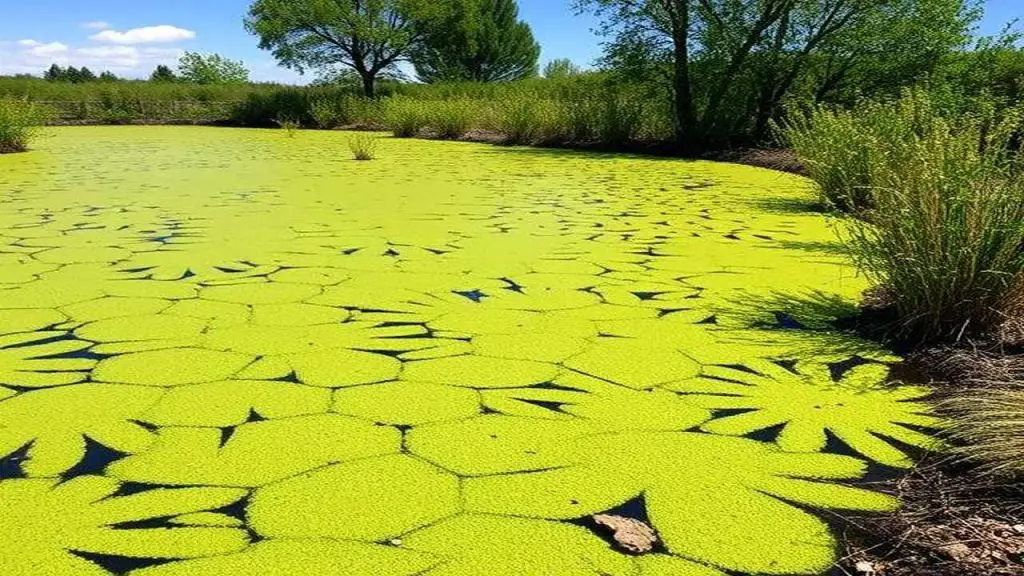
It’s easy to maintain balance in small ponds, the same strategies don’t work well with bigger ponds. Algae-eating plants are your best bet for these.
A. Tailoring Plant Selection to Specific Pond Conditions
Large ponds have zones varying in depth and condition. Here’s how to match:
- Marginal plants (e.g., cattails, pickerelweed): Line the edges to filter runoff and trap sediment.
- Submerged oxygenators (e.g., hornwort, anacharis): Anchor in deeper zones to oxygenate water and absorb nutrients.
- Floating plants (e.g., water hyacinth, duckweed): Cover open water to block sunlight and starve algae of energy.
Tip: Map your pond’s zones and plant accordingly for full coverage.B. Implementing a Comprehensive Multi-Plant Approach
A single plant species will not be enough to cover each aspect of algae control. Group them by roles – plants for shade, filtration, and oxygen levels. This strategy will help:
- Reduce light penetration at all depths.
- Absorb excess nutrients throughout the water column.
- Enhances biodiversity, leading to more effective natural filtration.
C. Balancing Nutrient Levels and Organic Matter
Balancing nutrient levels and organic matter is key to control algae overgrowth. Too much-decaying debris or runoff will overload the system with nitrogen and phosphorus, letting algae thrive. Use nutrient-absorbing plants, remove dead leaves regularly, and test water quality monthly to keep everything in check naturally.
Now that our large ponds are under control, let’s ensure the whole ecosystem stays healthy over time by learning the best practices to establish a healthy pond.
Best Practices for Establishing a Healthy Pond Ecosystem
With little planning and regular attention, you can build a balanced, self-sustaining system that thrives year-round.
A. Patience in Allowing Natural Processes to Establish
Algae blooms, murky water, and imbalanced nutrient levels are usual in the early weeks. This is nature’s way of sorting itself out. Beneficial bacteria need time to colonize your filters and substrate, and aquatic plants must settle in before they begin absorbing excess nutrients.
A healthy pond ecosystem balance will take time, give it a season or two to truly stabilize.
B. Avoiding Common Pitfalls in Pond Setup
Skip the trial-and-error by avoiding these rookie mistakes:
- Overstocking fish too early, or adding too many at once
- Using too few or the wrong mix of pond plants
- Placing the pond in full, unshaded sun all-day
- Overcleaning, which disrupts beneficial bacteria colonies
- Relying only on algaecides instead of addressing root causes
C. Monitoring and Adjusting Plant Populations as Needed
In warmer months, some species like Water Hyacinth or Duckweed can take over and block oxygen and light.
Others may decline in colder weather and need replanting or support. Aim for 40–60% surface coverage during the growing season, that sweet spot helps control light, manage nutrients, and support fish and insect life naturally.
D. Seeking Expert Advice for Complex Pond Management
If problems persist, like recurring blooms, poor water quality issues or clarity, or aggressive plant growth, don’t hesitate to ask for help.
Local pond experts, extension services, or water garden centers can offer tailored advice based on your climate and pond size. Sometimes, professional insight can save you months of frustration and keep your pond healthier in the long run.
Conclusion
Controlling algae doesn’t have to mean harsh chemicals or constant battles. With the right mix of floating, submerged, emergent, and marginal plants, you can restore balance to your pond and keep algae in check naturally.
From nutrient-hungry oxygenators like hornwort to shade-giving beauties like water lilies, each plant plays a role in building a thriving aquatic ecosystem. Add smart pond design, proper placement, and routine care to the mix, and your pond transforms from algae-prone to self-sustaining.
Algae will always try to creep in, but with patience, planning, and the power of plants, your pond can stay clear, healthy, and beautiful all year round.
Amazon and the Amazon logo are trademarks of Amazon.com, Inc, or its affiliates
